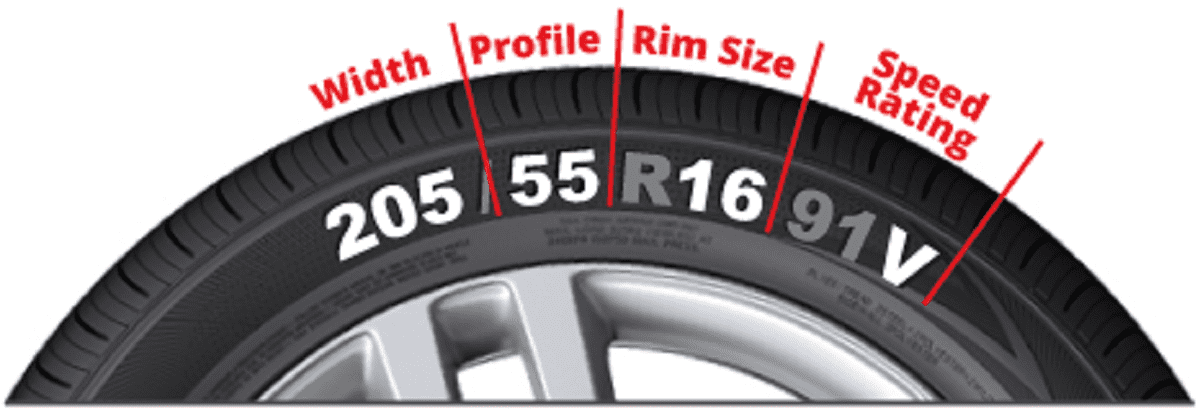Most tire manufacturers recommend replacing tires after they reach six years of age. They embossed the tire manufacture date along with other critical information on the product’s sidewall.
As you read these inscriptions, you might find the letters and numbers confusing. So, how to read Michelin tire date codes?
Michelin tire dates can be found in the last grouping of 3 or 4 numbers in the DOT tire code. The first two digits represent the week of manufacture while the last two numbers specify the year the tire was produced. For instance, a DOT code that ends in “0512” means the tire was made in the 5th week of 2012.
Table of Contents
Whether you like it or not, tires expire after ten years at the latest because they contain organic materials that degrade over time. For example, tires made of rubber lose their elasticity as they age.
Some tires may break down faster than other brands because the compounds react differently to various factors like heat, ice and other driving conditions. So not knowing when exactly to replace them may compromise your safety.
For these reasons, tire manufacturers use markings to help vehicle owners estimate how long they can use certain products, even if the brand promises strong treadwear warranty like Michelin.
There is no specific regulation that standardizes the placement of any tire date code Michelin inscribes, but there are two ways to find this information.
1. Use the tire date code chart printed in your dealer registry card.
2.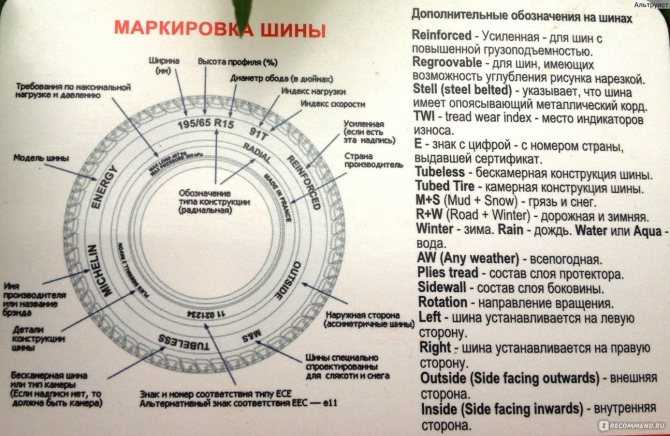 Check the DOT tire code in the inner or outer sidewall of your tire.
Check the DOT tire code in the inner or outer sidewall of your tire.
To make sure that you know how to tell when tire was made, it is important to familiarize yourself with the type of information included in Michelin DOT code lookup.
The Michelin tire sidewall displays three sections of sequences. They are:
1. Tire Specification
This is the most visible section because it reveals the following:
In brief, it may look like this: P 245/50 R17 98V
Note that if you don’t find any “P” letter in the code, it means that the tire follows Euro metric size. Such a model will have a higher load than its P-metric counterpart.
Such a model will have a higher load than its P-metric counterpart.
2. Michelin Tire DOT Code Decoder
After the word “DOT,” you’ll find the plant location, manufacturing code, and the tire’s birthday.
In other words, the Michelin tire manufacture date can be found at the end of the second section. They are the last four digits of the tire code, usually below the tire specs.
This sequence is also called the DOT safety code or DOT TIN (Department of Transportation Tire Identification number). It can be up to 13 characters.
3. UTQG rating
UTQG stands for Uniform Quality Tire Grading. This section shows the tire’s treadwear, traction, and temperature grades as determined by National Highway Traffic Safety Administration (NHTSA).
The DOT stamp has the following codes in order from first to last:
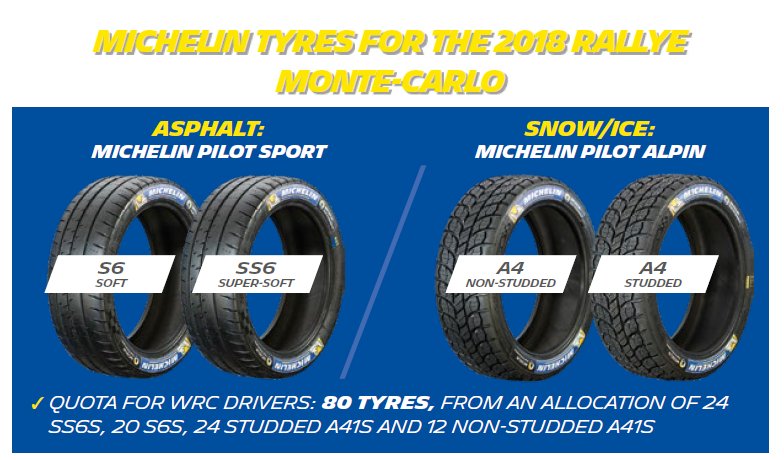
For example, 001x and 002x were traced in a complaint for Michelin Pilot Sport.
So if you feel that the manufacturing code is unusual like 006x or 009x, it’s not the date the tire was made. You’ll need to focus on the next few digits for that, which are the year and week codes.
Remember that the tire date code before 2000 has three numbers in the last grouping of the DOT sequence. The first two digits represent the week of the year while the third or last number indicates the year of manufacture.
For example, if the DOT code ends with “214,” it means the tire was built during the 21st week of 1994.
Meanwhile, models made after 2000 will have four numbers, wherein the first two digits specify the week the tire was made and the remaining two digits refer to the manufacture year.
As an illustration, if the last four numbers of the DOT code are “0514”, then the tire was made in the 5th week of 2014.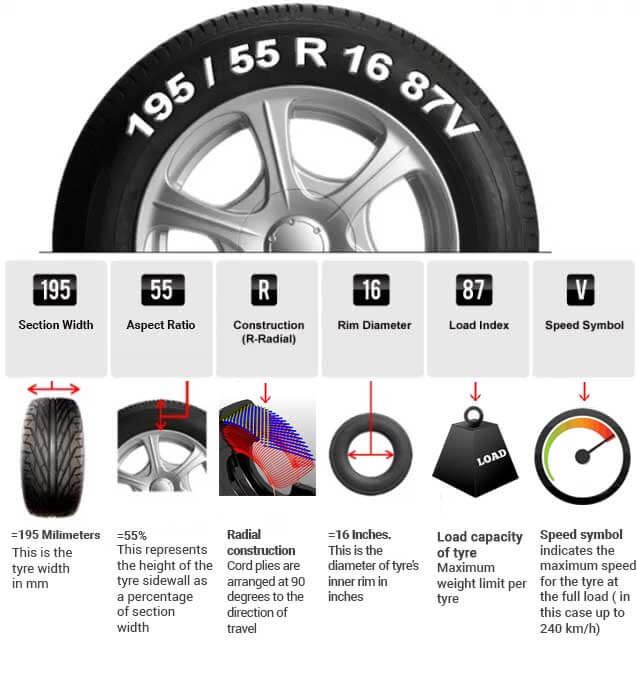
Now that you know how to identify which code stands for tire manufacture date location and other info, you can calculate Michelin tire age.
Even if Michelin produces different designs of sidewalls, be assured that the date code on Michelin tires is always printed on both sides of the sidewalls.
Learning how to read Michelin tire date codes is a basic skill for vehicle owners.
At first, the tire markings may seem confusing because they use different sets of letters and numbers. It is possible to mix up the week of manufacture with the production year.
Reading the codes on the tire’s sidewall will be a piece of cake if you familiarize yourself with the arrangement of the information such as the DOT, plant code, manufacturing code, etc.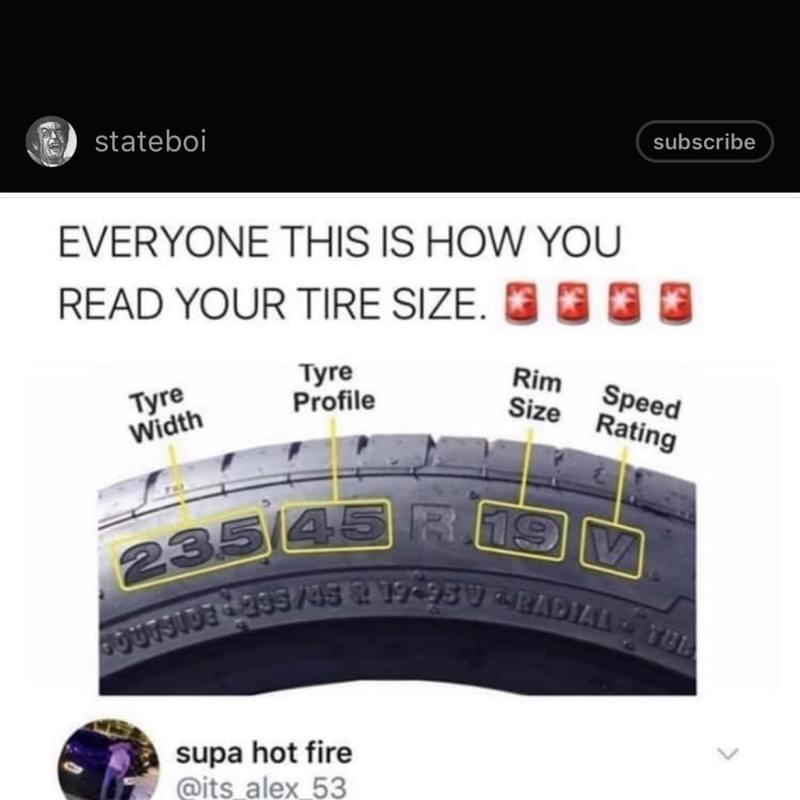
If you find this guide helpful, feel free to tell us other topics you would like to learn about.
I'm Henry, the content writer for PPMC Transport. We build our site entirely on experience and extensive market and customer research. My goal is to create a trusted platform where people can go to determine what is best for their vehicles in terms of safety and convenience. Keep an eye out for our useful guide!
- Speciale Henry
Decoding your car's tire information doesn't require flipping through the owner's manual. All the information you need is right there on the sidewall. You just have to know how to crack the code. Not only do the jumble of letters and numbers tell you the size of the tire, but they can also tell you how safe your tires are and how old they are, too.
Let's take a look at the tires on Roadshow's long-term 2018 Kia Stinger for example.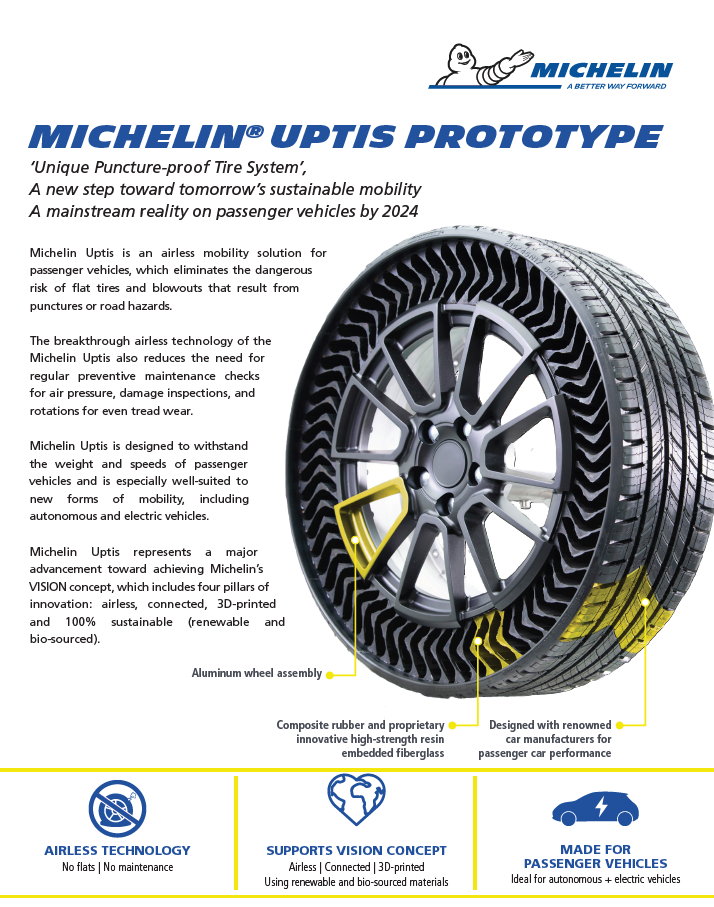
The biggest stamping on the tire is the brand and model, in this case Michelin Pilot Sport 4. On this particular tire, there is also a note of "outside." This indicates that the tires are asymmetric and have a change of tread pattern across the tire that can disperse water while also maintaining dry grip.
You might be confused by the following string of letters and numbers: "255/35 ZR19 (96Y)." That looks like someone's email password, doesn't it? 255/35 indicates that the tire is 255 millimeters wide, with a 35-percent sidewall aspect ratio. In other words, the height of the sidewall is 35 percent of the tread width.
Yes, tires make you do math.
Multiply 255 by 0.35 to get an 89.25 millimeter sidewall height. If you want to convert either of those numbers to inches, divide by 25.4, the number of millimeters in an inch. These tires are 10 inches wide and have a sidewall height of 3.5 inches.
The "Z" indicates a speed rating of over 149 mph.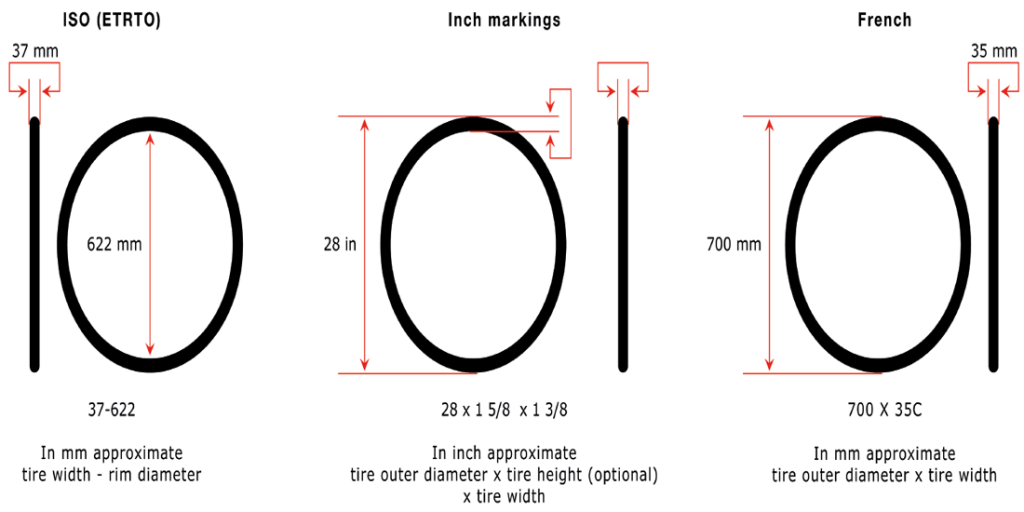 There's more to it, however, and I'll explain the rest a bit further on.
There's more to it, however, and I'll explain the rest a bit further on.
"R" tells us that the tire has a radial construction. Radials are by far the most common type of passenger-car or truck tire, where the plies are situated perpendicular to the direction of travel.
In rare cases, perhaps if you drive a classic car on vintage-spec tires, you may see a "D" here, which indicates a diagonal or bias-ply construction. In these tires, the plies overlap each other on a diagonal.
Enlarge ImageNo, those letters and numbers aren't random.
Emme Hall/RoadshowYou may also see the designation "F" after the construction-type symbol. This means the tire is a run flat and can be driven at slower speeds for a short distance after a puncture -- even after a complete loss of air pressure. Typically, the guideline in such scenarios is 50 mph for 50 miles.
"19" simply means the tire should be mounted on a wheel with a rim diameter of 19 inches. Luckily, no math is needed here.
Luckily, no math is needed here.
On some tires you may see the note "M+S," which means the tire has been rated for mud and snow. You may also see a three-peak mountain graphic with a snowflake, indicating the tire is a step above an M+S tire for foul-weather performance.
It's important to note that neither of these symbols means the tire is specifically designed for mud or snow, just that it's been engineered to handle greater amounts of the slippery stuff than tires that don't have these markings. If you plan on driving in the deep snow or mud, you should consider a more specialized winter or off-road tire, respectively.
After the tire's size, you'll see its service description, here indicated by "(96Y)". The number is the load index. The higher the number, the more weight the tires can handle. In this case, "96" means the tire can handle 1,565 pounds, while the "Y" indicates the tire is rated to be safe at speeds up to 186 miles per hour.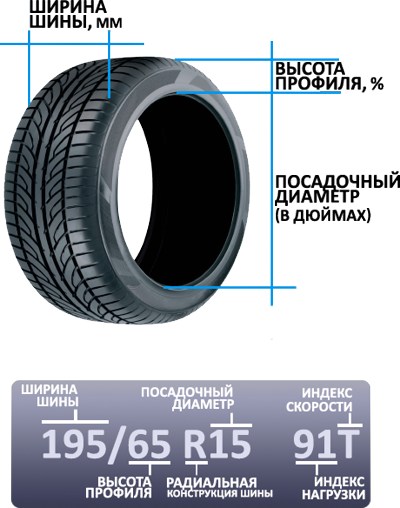
But what about that "Z" rating mentioned earlier? "Z" means that the tire has been tested over 149 mph, but doesn't indicate how far over. The "Y" rating basically puts the cap at 186 mph. Except here, the designation is in parentheses, indicating that the tire has been tested above 186 mph. However, again it doesn't indicate how far over 186 mph that testing was done.
These speed ratings might matter to folks who take their Lamborghini Huracán to the track and have the capability of going over 186 mph, but for most of the driving public, a Y-rated tire, parentheses or no, should be more than sufficient for all street use.
If you'd like to see what the ratings are for your particular tire, Tire Rack has a few excellent charts here.
The Department of Transportation leaves its mark on tires as well. On the sidewall, you'll find DOT followed by a series of numbers that indicate such things as manufacturing location and specs. However, the most important numbers are the last four, indicating the week and year the tire was made.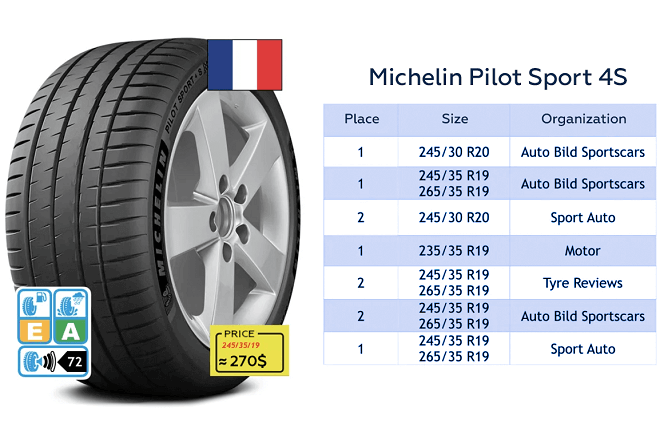 In this case "1417" means it was made between April 3-9, 2017.
In this case "1417" means it was made between April 3-9, 2017.
The Department of Transportation is trying to communicate with you.
Emme Hall/RoadshowThis information can be useful when assessing whether tires need to be replaced (which can be particularly helpful when shopping used cars). If the tires are over five years old, regardless of tread depth, it's time to get them inspected, and most likely replaced.
This born-on dating can also be helpful when attempting to figure out if your tires are affected by a recall.
The Uniform Tire Quality Grade Standards are also molded on the tires, indicating treadwear, traction and temperature tolerances. While the tests to determine these criteria rely on standards set by both the DOT and National Highway Traffic Safety Administration, the testing itself is performed by the manufacturer, or an outside company it hires.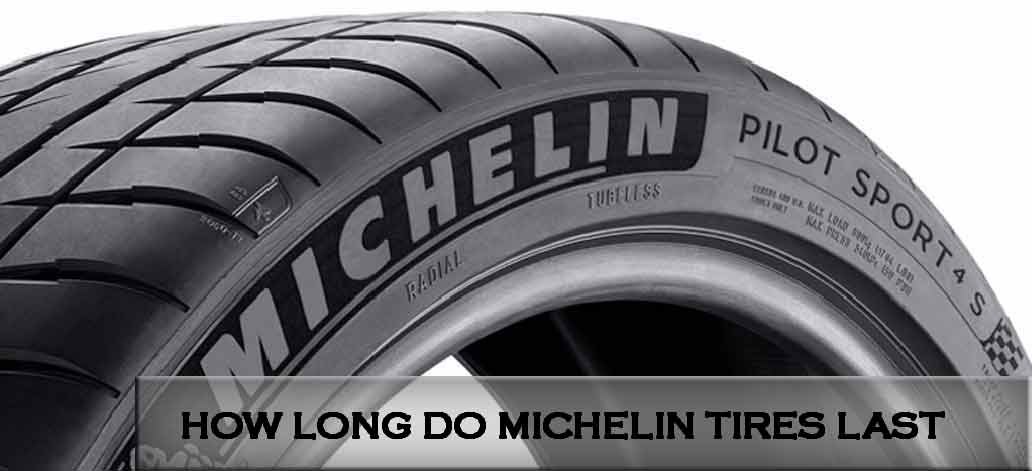
Treadwear testing is done on a controlled test track over 7,200 miles, and the resulting rating is comparative in relation to the test tire. A treadwear rating of 100 means the test subject is estimated to last as long as the test tire. Ergo, a tire rated at 200 promises to last twice as long as the test tire, but wear out twice as quickly as a tire rated at 400.
Enlarge ImageThese Michelin Pilot Sport 4 tires get good UTQGS ratings all around.
Emme Hall/RoadshowFrankly, UTQGS isn't always the best way to determine probable wear, as the test tire runs through so few miles and wear will vary based on driving style and real-world conditions. Tire manufacturers' treadlife warranties are often a more useful indicator of projected life.
Traction rating designates a tire's wet stopping ability. The Michelins get the highest rating of AA, but you might see A, B or C here.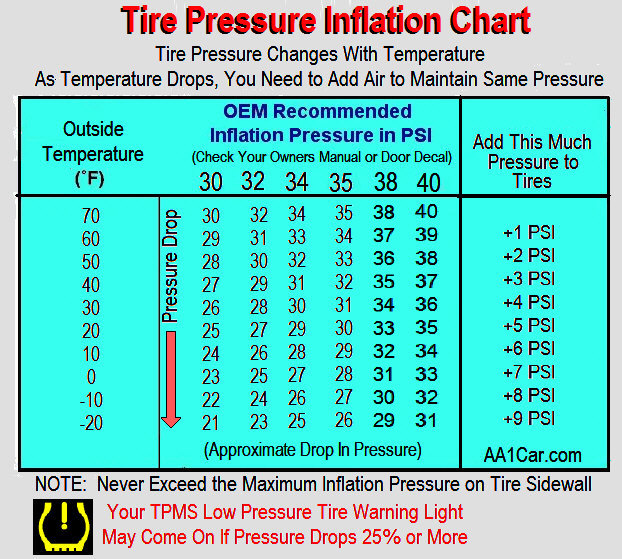
The temperature rating grades the tire on its ability to resist heat. A tire that can't dissipate heat will not be able to run safely at high speeds. The law requires a minimum grade of C, but the Michelins fitted on this particular Stinger go to the top of the class with an A grade.
Maximum load and tire pressure information must be marked on every tire sold in the United States. On these tires, we see noted "Max Load 710 kg" (1565 lbs) and "Max Press 340 kPa" (50 psi). This is not the same thing as the recommended tire pressure. For that information you should refer to the owner's manual or the information sticker on the driver's side door jamb.
Enlarge ImageIf you don't want to look up the load rating, it's also written out right on the tire.
Emme Hall/RoadshowYou may also see an "E" with a number in a circle followed by some numbers. This means the tires meet European specifications, which vary slightly from US standards. Other codes include NOM for Mexico, CCC for China, SNI for Indonesia and N superimposed over an I for Brazil.
Other codes include NOM for Mexico, CCC for China, SNI for Indonesia and N superimposed over an I for Brazil.
There is a lot to learn from the seemingly random assortment of numbers and letters on your tire's sidewall. Now that you know how to crack the code, you'll be able to take better care of your tires, or figure out when it's time to invest in new ones.
Originally published July 2018.
Do you want to choose a tire for your car, but do not understand tire markings well? It's not a problem! In this section, we will help you figure out what tire parameters are, what they mean, and which tire is right for your car.
Find tires / tire catalog
195/65 R15 91 TXL
195 is the tire width in mm.
65 - Proportionality, i.e. profile height to width ratio. In our case, it is equal to 65%.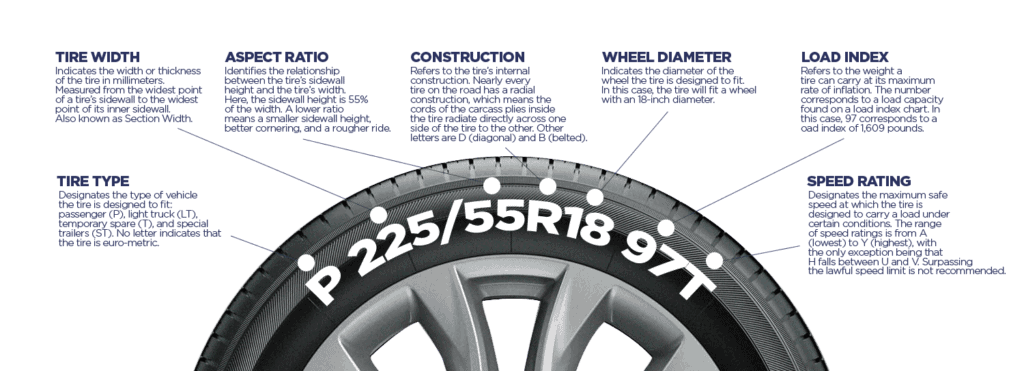 Simply put, with the same width, the larger this indicator, the higher the tire will be and vice versa. Usually this value is simply called “profile”.
Simply put, with the same width, the larger this indicator, the higher the tire will be and vice versa. Usually this value is simply called “profile”.
Since the tire profile is a relative value, it is important to take into account when choosing rubber that if you want to put tires with a size of 205/65 R15 instead of the size 195/65 R15, then not only the width of the tire will increase, but also the height! Which in most cases is unacceptable! (except when both of these sizes are indicated in the car's operating book). You can calculate the exact data on changing the outer dimensions of the wheel in a special tire calculator.
If this ratio is not specified (for example, 185/R14C), then it is equal to 80-82% and the tire is called full profile. Reinforced tires with this marking are usually used on minibuses and light trucks, where a large maximum wheel load is very important.
R - means a tire with a radial cord (in fact, almost all tires are made this way now).
Many mistakenly believe that R- means the radius of the tire, but this is precisely the radial design of the tire. There is also a diagonal design (indicated by the letter D), but recently it has practically not been produced, since its performance is noticeably worse.
15 - wheel (rim) diameter in inches. (It is the diameter, not the radius! This is also a common mistake). This is the “landing” diameter of the tire on the disk, i.e. is the inside size of the tire or the outside of the rim.
91 - load index. This is the level of maximum permissible load on one wheel. For passenger cars, it is usually done with a margin and is not a decisive factor when choosing tires (in our case, IN - 91 - 670 kg.). For minibuses and small trucks, this parameter is very important and must be observed.
T - tire speed index. The larger it is, the faster you can ride on this tire (in our case, IS - H - up to 210 km / h).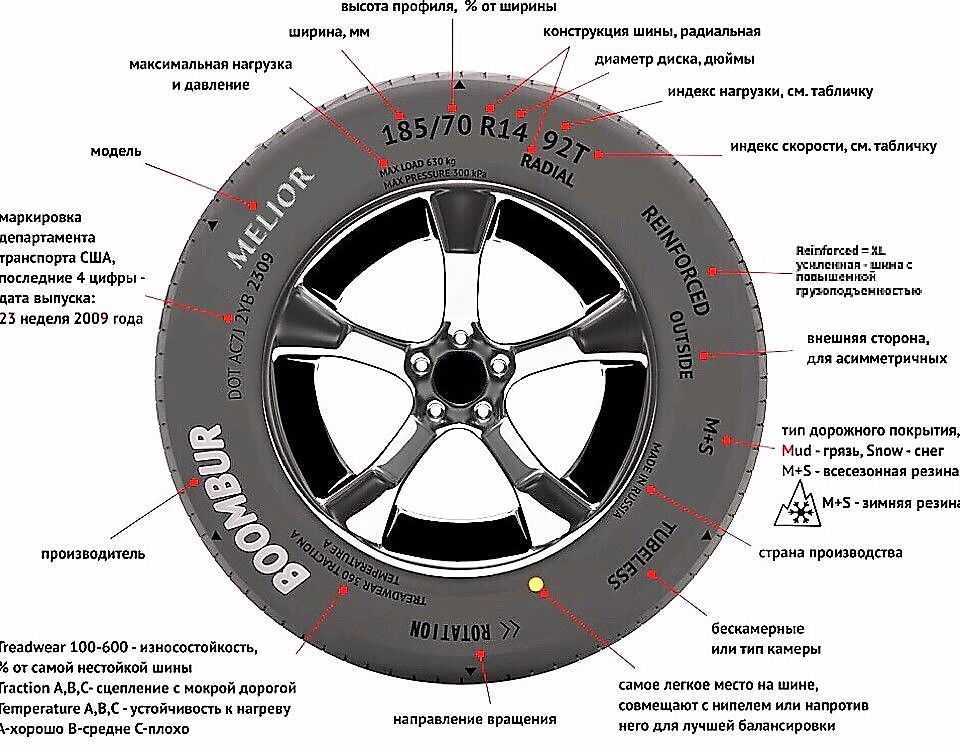 Speaking about the tire speed index, I would like to note that with this parameter, the tire manufacturer guarantees the normal operation of the rubber when the car is constantly moving at the specified speed for several hours.
Speaking about the tire speed index, I would like to note that with this parameter, the tire manufacturer guarantees the normal operation of the rubber when the car is constantly moving at the specified speed for several hours.
There are two different markings for American tires. The first one is very similar to the European one, only the letters “P” (Passanger - for a passenger car) or “LT” (Light Truck - light truck) are placed before the size. For example: P 195/60 R 14 or LT 235/75 R15. And another tire marking, which is fundamentally different from the European one.
Example: 31x10.5 R15 (corresponding to European size 265/75 R15)
31 is the outside diameter of the tire in inches.
10.5 is tire width in inches.
R - a tire with a radial design (older tire models were with a diagonal design).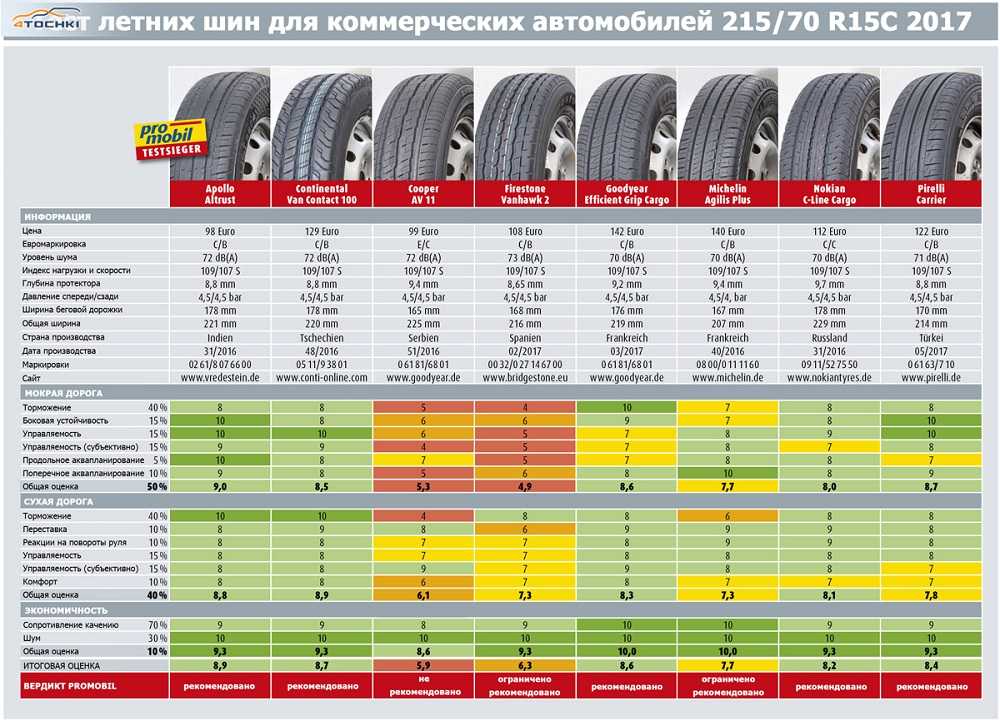
15 is the inner diameter of the tire in inches.
Generally speaking, except for inches that are unusual for us, the American tire marking is logical and more understandable, unlike the European one, where the height of the tire profile is not constant and depends on the width of the tire. And here everything is simple with decoding: the first digit of the standard size is the outer diameter, the second is the width, the third is the inner diameter.
XL or Extra Load is a reinforced tire, the load index of which is 3 units higher than that of conventional tires of the same size. In other words, if a given tire has a load index of 91 marked XL or Extra Load, then this means that with this index, the tire is able to withstand a maximum load of 670 kg instead of 615 kg (see the table of tire load indices).
M+S or M&S tire marking (Mud + Snow) - mud plus snow and means that the tires are all-season or winter.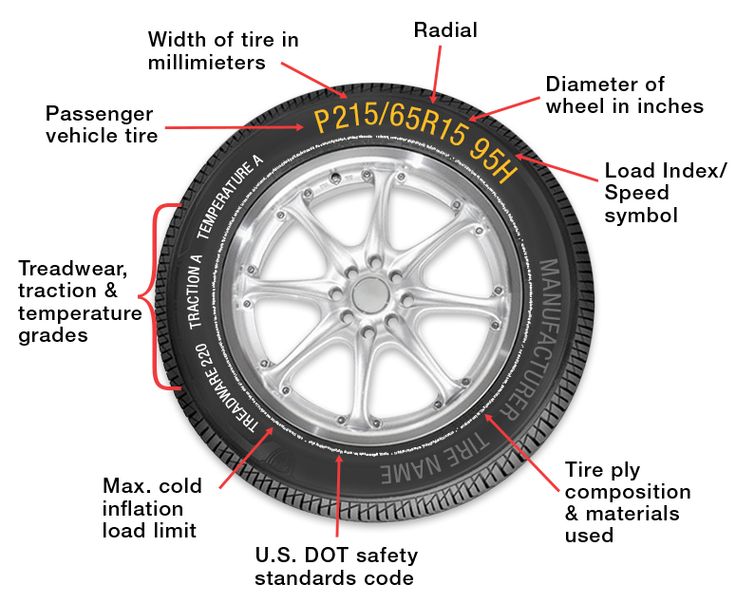 Many summer tires for SUVs are labeled M&S. However, these tires must not be used in winter, as winter tires have a completely different rubber compound and tread pattern, and the M&S badge indicates good flotation performance.
Many summer tires for SUVs are labeled M&S. However, these tires must not be used in winter, as winter tires have a completely different rubber compound and tread pattern, and the M&S badge indicates good flotation performance.
All Season or AS all season tires. Aw (Any Weather) - Any weather.
Pictogram * (snowflake) — rubber is designed for use in harsh winter conditions. If this marking is not on the sidewall of the tire, then this tire is intended for use only in summer conditions.
Aquatred, Aquacontact, Rain, Water, Aqua or pictogram (umbrella) - special rain tires.
Outside and Inside ; asymmetric tires, i.e. It is important not to confuse which side is the outside and which is the inside. When installing, the Outside inscription must be on the outside of the car, and Inside on the inside.
RSC (RunFlat System Component) - RunFlat tires are tires on which you can continue to drive a car at a speed of no more than 80 km / h with a FULL drop in pressure in the tire (due to a puncture or cut).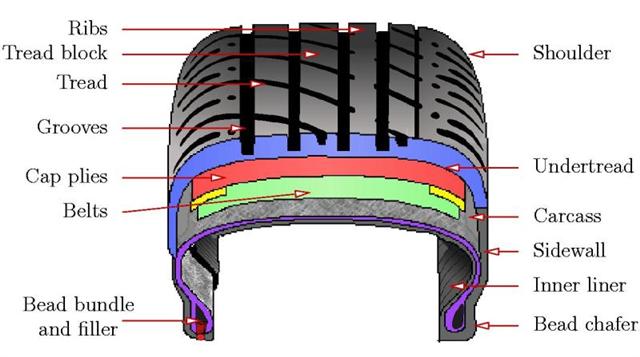 On these tires, depending on the manufacturer's recommendations, you can drive from 50 to 150 km. Different tire manufacturers use different designations for RSC technology. For example: Bridgestone RFT, Continental SSR, Goodyear RunOnFlat, Nokian Run Flat, Michelin ZP etc.
On these tires, depending on the manufacturer's recommendations, you can drive from 50 to 150 km. Different tire manufacturers use different designations for RSC technology. For example: Bridgestone RFT, Continental SSR, Goodyear RunOnFlat, Nokian Run Flat, Michelin ZP etc.
Rotation or arrow This marking on the tire sidewall indicates a directional tire. When installing the tire, you must strictly observe the direction of rotation of the wheel, indicated by the arrow.
Tubeless - tubeless tire. In the absence of this inscription, the tire can only be used with a camera. Tube Type - indicates that this tire must be used only with a tube.
Max Pressure ; maximum allowable tire pressure. Max Load - the maximum allowable load on each wheel of the car, in kg.
Reinforced or the letters RF in the size (for example 195/70 R15RF) means that this is a reinforced tire (6 layers). The letter C at the end of the size (for example 195/70 R15C) indicates a truck tire (8 layers).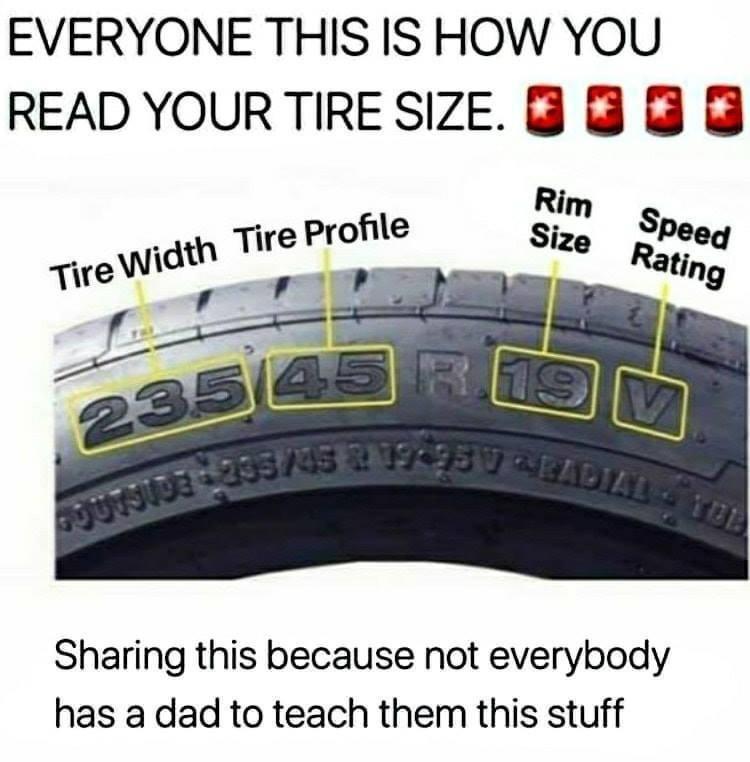
Radial this marking on the rubber in the standard size means that this is a radial construction tire. Steel means that there is a metal cord in the tire structure.
Letter E (in a circle) - the tire meets the European requirements of ECE (Economic Commission for Europe). DOT (Department of Transportation - US Department of Transportation) is an American quality standard.
Temperature A, B, or C Temperature resistance of the tire at high speeds on the test bench (A is best).
Traction A, B, or C Tire wet braking capability.
Treadwear ; relative expected mileage compared to a specific US standard test.
TWI (Tread Wear Indiration) - tire tread wear indicators. The marking on the TWI wheel can also be with an arrow. Pointers are located evenly in eight or six places around the entire circumference of the tire and show the minimum allowable tread depth.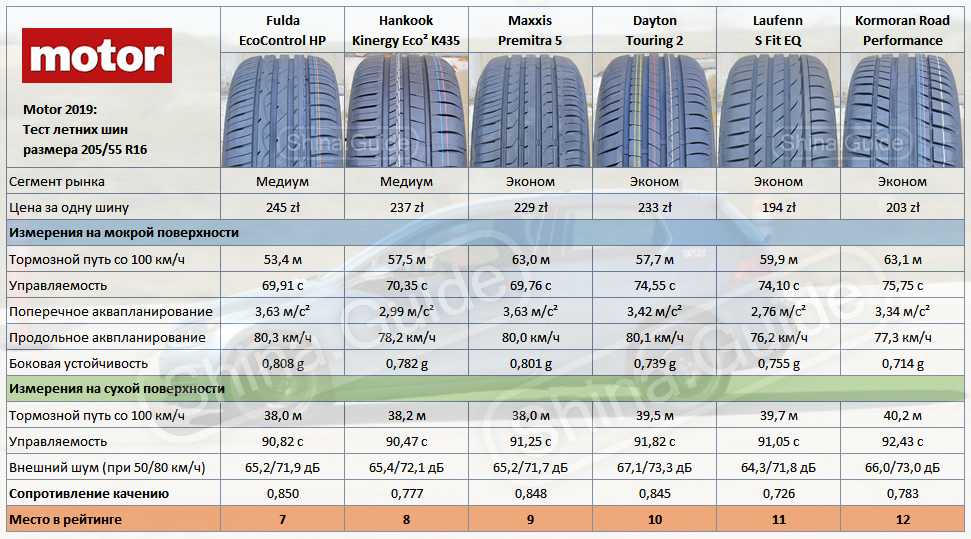 The wear indicator is made in the form of a protrusion with a height of 1.6 mm (the minimum tread value for light vehicles) and is located in the tread recess (usually in the drainage grooves).
The wear indicator is made in the form of a protrusion with a height of 1.6 mm (the minimum tread value for light vehicles) and is located in the tread recess (usually in the drainage grooves).
DOT - Manufacturer's coded address, tire size code, certificate, issue date (week/year).
Find tires / tire catalogMany modern drivers, when buying a set of car tires for any season, often ask themselves - what is the year of manufacture of the purchased tires?
Naturally, sellers, whether used material or new, of course, will say the year is newer than it really is. And here you only need to rely on yourself to understand how old the tires really are.
We will tell you how to determine the age of car tires and what methods exist for this.
Contents
 If you see wear on the surface of the working part of a car tire, then on its basis it is already worth further determining how long the tires have been in use. In the absence of wear, each driver will think that he has new tires in front of him, which were released this year.
If you see wear on the surface of the working part of a car tire, then on its basis it is already worth further determining how long the tires have been in use. In the absence of wear, each driver will think that he has new tires in front of him, which were released this year. Regarding the novelty, this will be true, but there may be slight misconceptions about the exact year of manufacture, since there are a large number of car tire sets in the world that were not sold and, accordingly, were not used for their intended purpose. These tires could lie on the counter for a week or several years. How to be in this case and find out how old the tires are?
In this case, the marking of car tires will help you, on which information about the manufacturer and year of manufacture must be indicated. On car tires from the French manufacturer Michelin, you will definitely be able to find such information, it is enough to carefully examine the side of the tire to see an engraved marking on it indicating the necessary data.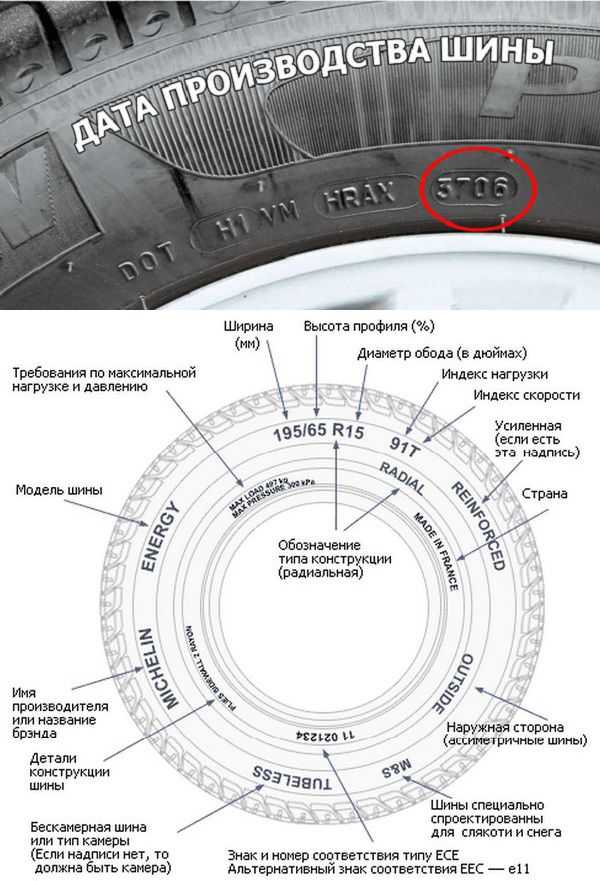 However, there are cases when, due to wear, the marking is not visible or is read very poorly. In this case, you can only determine the age of car tires approximately, by eye.
However, there are cases when, due to wear, the marking is not visible or is read very poorly. In this case, you can only determine the age of car tires approximately, by eye.
Determining the age of Michelin car tires is quite an important undertaking for drivers, because it is necessary to always correctly evaluate the life of the car tires used, the margin of safety and all key performance characteristics. When determining age, drivers can also find out the approximate life of purchased car tires from the French manufacturer Michelin, which will help drivers determine how long he will use a set of tires.
It's not a secret for anyone that car tires from the French manufacturer Michelin have a fairly long service life. In general, the manufacturer claims that his products may not lose their best qualities for at least 3-4 seasons. This suggests that, in principle, these tires can be used for 5-6 years. In fact, this is a fairly long period, which indicates a very large resource.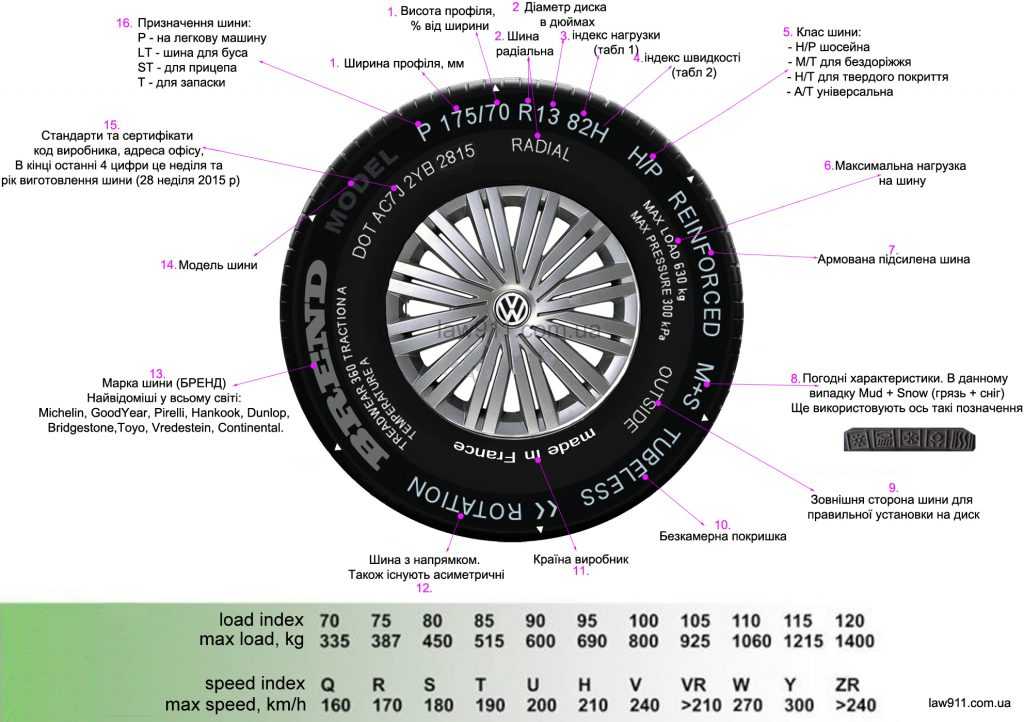
This is true - Michelin tires have a very serious margin of safety, which is manifested due to the fact that the manufacturer, in the manufacture of all modifications of his own products, used the optimal composition of the components that were included in the rubber compound of Michelin tires. These are absorbent gels, and synthetic substances, and natural rubber. Together, the combination of these components made it possible to use tires of very high quality, which still delight a large number of drivers, not only in Europe, but throughout the world.
Despite the fact that Michelin car tires have a fairly serious margin of safety, nevertheless, it is necessary to preserve this advantage of your tires in order to use them as long as possible. In fact, in order to keep Michelin tires in excellent condition for a long period of time, you just need to follow a few rules.
First, you need to move as carefully as possible.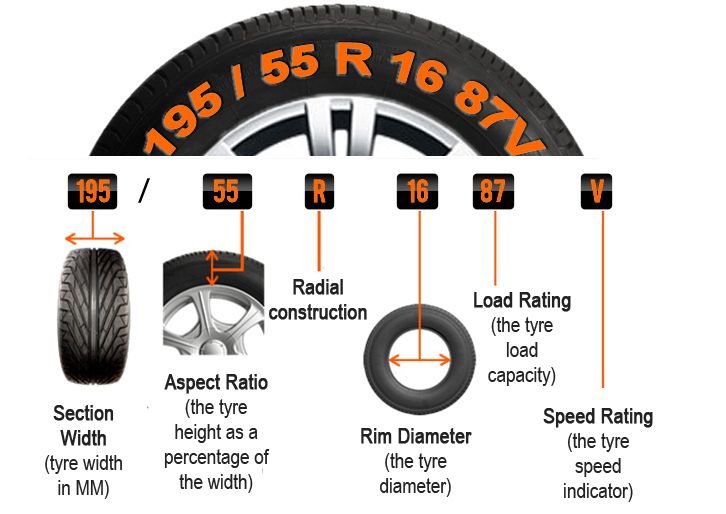 This is a rather abstract concept, since each driver has his own driving style, from which it is very difficult to deviate in favor of something. You just need to try to drive on a level surface, as well as ensure a driving style in which you will have a minimum of sharp maneuvers - turning, starting, braking, drifting, etc. These are the factors that can have a serious impact on the final quality of your Michelin tires.
This is a rather abstract concept, since each driver has his own driving style, from which it is very difficult to deviate in favor of something. You just need to try to drive on a level surface, as well as ensure a driving style in which you will have a minimum of sharp maneuvers - turning, starting, braking, drifting, etc. These are the factors that can have a serious impact on the final quality of your Michelin tires.
Secondly, at the time when the season of use of your tires ends, you need to store them in a strictly defined place under certain conditions. It is well known that rubber products tend to contract and expand, and this can ultimately play into the reduction of the strength characteristics of Michelin car tires during a long period of storage in inappropriate conditions - even though Michelin car tires have excellent rubber quality.
Third, when changing kits at the start of the new season, be careful when removing tires. Even such durable and dense tires as the French manufacturer Michelin's car tires are sensitive to strong deformations and external influences, therefore, also exercise maximum caution and be extremely careful.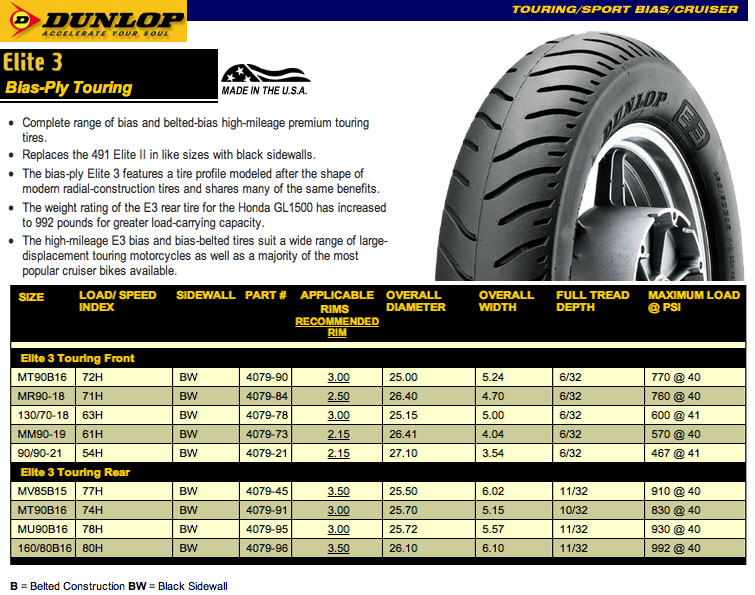
As it becomes clear, there are few ways to find out the age of Michelin car tires. Most importantly, try to determine the age as approximately as possible, since it is very, very difficult to determine the exact age, especially if car tires have already been used by any driver before.
The most important thing to pay attention to when determining age is determining the tread height of Michelin tires. To do this, it is enough to measure this value as accurately as possible and compare it with the standard value. If the difference between these values is relatively small, then the age of such tires will also be small. With an increase in this value, the age of car tires will also increase accordingly.
The most important thing for drivers is to try to keep the quality of the used Michelin car tires for as long as possible.